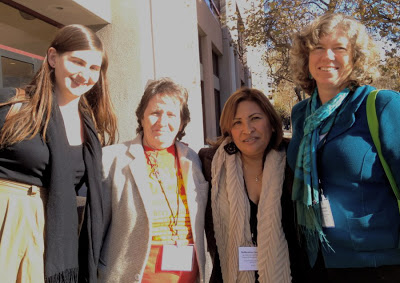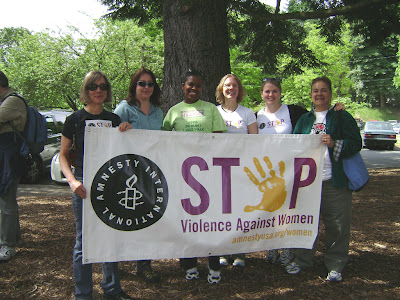January 28, 2013

From left to right: Translator (name unknown), Maria Reyes of the National Domestic Workers Alliance, Guillermina Castellanos of the National Day Labor Organizing Network, panel moderator Kathy Coll of Stanford University. Photo by author.
By Seline Szkupinski Quiroga, Ph.D.
Last November in Oakland, at the meetings of the National Women’s Studies Association, I attended a session entitled “Imagining New Solutions for Old Problems: Domestic Workers Create Networks – Transforming the Struggle for Social and Economic Justice”. The panel offered academic, activist, and worker voices reflecting on the current state of labor activism in a field comprised largely of immigrant women.
Historian Eileen Boris provided a context for current struggles as she outlined the dialectical history of strikes (protests) and standards (laws). Maria Reyes of Mujeres Unidas y Activas (an immigrant rights organization) and the National Domestic Workers Alliance described initiatives such as the California Domestic Workers Bill of Rights which would have given housekeepers, childcare providers and home health care workers rights such as overtime pay, mandated meal and rest breaks, adequate sleeping conditions for live-in workers, and the right to use employers’ kitchens to cook their own food. (The bill was vetoed by Governor Brown).
Nicole Brown-Booker, a professional woman with a significant disability who must employ personal care attendants in order to live independently, spoke of Hand in Hand, a coalition of domestic workers and their employers working together to educate about and advocate for dignified and respectful working conditions. Pam Tau Lee, a long-time community and labor activist, shared her experience as a daughter now employing care workers for her elderly parents.
The entire session was inspiring and enlightening but it was these last two presenters who had the most impact on me. Their stories resonated with me because I have had experience with the ethical dilemmas associated with employing a home health care worker. My mother had Parkinson’s disease and osteoporosis. In her later years, she lived with my sister and her family as she was no longer able to live independently due to her frailty and advancing symptoms. My sister and her husband both worked fulltime and couldn’t provide the 24-hour care my mother needed.
As for many families in this situation, financial concerns were paramount. My mother had limited resources—social security, a small pension and some savings. She did not have long-term care insurance so while her health insurance covered a few hours of home health care, the majority was paid for out of pocket. Daunted by the task of finding qualified workers with experience and figuring out tax withholdings at the same time as learning about my mother’s rapidly changing needs, we decided to contract with a private company, and the monthly expense quickly mounted.
My mother immigrated to the United States in the 1950s. She was completely bilingual but as she aged, she was more comfortable expressing herself in Spanish. We were grateful to find home health care workers who could easily communicate with her in Spanish, but I was uncomfortably aware that the limited English abilities of some would limit their ability to advance or to be employed in other sectors. I learned that few companies provided opportunities for training and certification.
I have respect for the work of caring for others. It is not an easy job, and it is more than just providing another pair of hands. In my mother’s case, for example, it required confianza as workers helped her make purchases and with intimate daily tasks; and patience as the side effects of her medications—hallucinations and paranoia—caused personality changes. In one particularly difficult period, her aides would spend hours looking for something that had been ‘lost’ only to then be accused of theft. My sister, in addition to managing her own household, had to mediate these clashes.
Over the years that my mother needed home health care workers, we learned that of the daily amount she was charged, only a small portion actually went to the worker. I don’t know if this is standard or just a practice of the companies we dealt with. We wanted to pay a fair wage and give the work and care provided the dignity and value it deserved. At one point, we intervened when we found out that one of my mother’s aides was consistently receiving her paychecks late. The company’s proposed ‘solution’ was for my mother to buy out the worker’s contract at a cost of over $30,000. The situation was so messy we had to seek legal counsel. As my mother’s medical condition was rapidly declining, shifting from using a company to employing home health care workers directly would have meant finding a new team of workers who could attend to her needs, and forming new relationships at a time when stability was important.
The decision of what to do was eclipsed by my mother’s entrance into hospice.When my mother passed away, her home health care workers attended her memorial service, and I am still in contact with some of them as they share the accomplishments of their children and other milestones.
Domestic workers, such as the many women who helped my mother in her last years of life, provide vital services yet these workers often face unjust social and economic conditions. The industry is unregulated, domestic workers are excluded from the protections of federal wage-and-hour laws, and abuses are rampant. However, as the presenters in the session noted, the coalitions and networks that domestic workers are forming are having effect. In 2010, New York State passed the nation’s first Domestic Workers Bill of Rights into law. Although Governor Brown vetoed the California version, local organizations have not given up the fight. San Francisco’s Mujeres Unidas y Activas has developed an innovative worker-centered skills training, job placement and labor rights program called Caring Hands. A national campaign to coordinate efforts and educate the public called Caring Across Generations launched in 2011.
As our population ages, it is estimated that the number of people who will need care will only grow.[1] We may all face similar dilemmas, as we have to make decisions about a sick parent or partner who needs help. It is time to organize to change the current structures and policies. We must improve the working conditions and job quality of domestic workers but not at the risk of making such care inaccessible for low-income families.
Seline Szkupinski Quiroga is a child of immigrants and a medical anthropologist living in Phoenix, Arizona. She is a member of the Mujeres Talk Colectiva.
[1] Salinas, Robert. “Home Care.” Long-Term Care Medicine (2011): 3-14.
Comment(s):
- Elena Gutierrez February 6, 2013 at 12:32 PM
Thanks for your thoughts on the complex relations women face as both carefivers and receivers- roles we all play at some point in our lives. Do you have any resources that those of us who would like to keep up on these issues can use? - Seline (Mujeres Talk Co-Moderator) February 7, 2013 at 3:52 PM
Hi Elena,
In addition to the links in the essay, the websites of the following organizations will keep you up to date:
National Domestic Workers Alliance
http://www.nationaldomesticworkeralliance.org/
Caring Across Generations
http://www.caringacrossgenerations.org/
The Domestic Employers Association
http://domesticemployers.org/
-ssq








